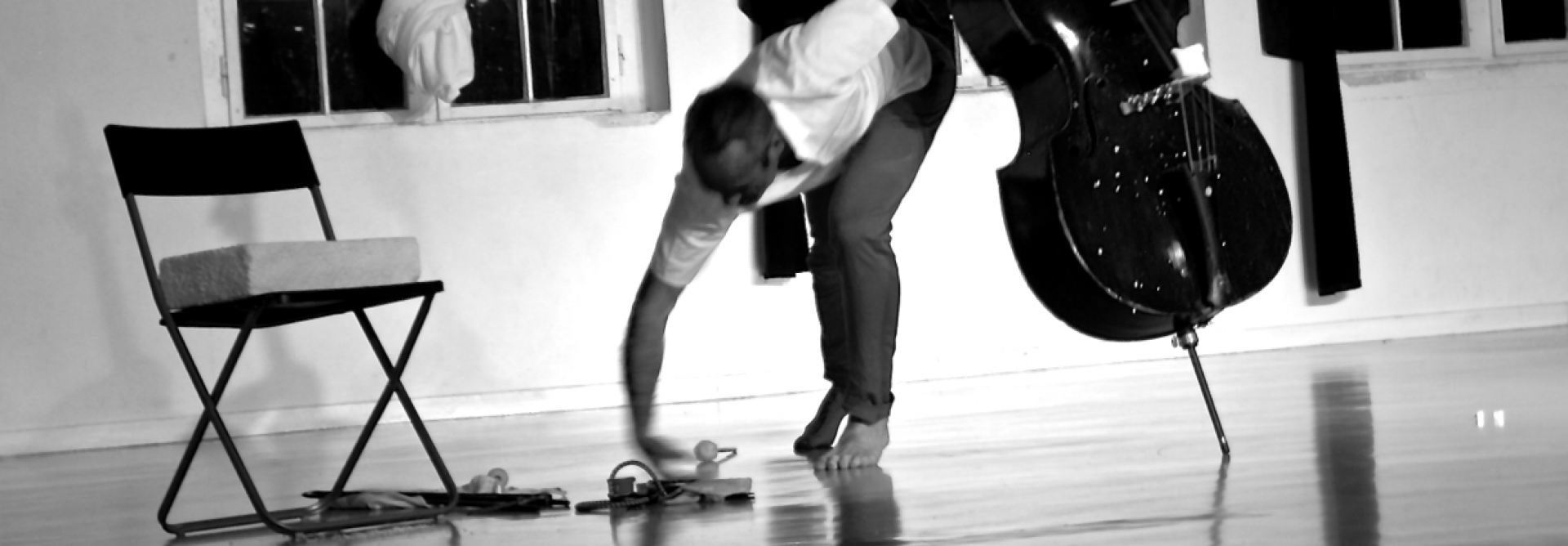Le label Creative Sources est en train de se faire une place incontournable de premier label dédié à l’improvisation libre radicale en nous livrant coup sur coup des enregistrements de première classe qui tiennent la comparaison avec les livraisons du label Emanem de la décennie passée. Deux de mes pages précédentes leur ont été entièrement consacrées en raison de l’urgence de la découverte.
Si le duo saxophone soprano / contrebasse est une association instrumentale souvent usitée, Ariel Shibolet et Alexander Frangenheim en exprime le nec plus ultra en choisissant une voie intense, radicale et focalisée sur une approche singulière. Shibolet sature la colonne d’air comme s’il grognait, sifflait ou aspirait, et Frangenheim frotte et percute son gros violon en mode permanent « sourdine » créant un dialogue dans les extrêmes de l’instrument. C’est en tout point remarquable. Toute la palette des grincements et frottements pour la contrebasse et des bruissements et chuintements du souffle dans un saxophone est sollicitée jusqu’à plus soif avec une belle expressivité. Les musiciens creusent profondément dans les ressources sonores pour établir une manière de conversation indicible, moins codée aboutissant à des surprises. Ce n’est pas le tout de découvrir des sons inouïs, il faut arriver à leur donner un sens dans l’instant en relation avec ceux de son partenaire et vice et versa. La tâche n’est pas simple et ces deux improvisateurs de grande classe y parviennnent faisant de leur Set of Music, un disque qui peut servir de référence à la question « C’est quoi la musique improvisée libre aujourd’hui ?? ». J’avais été subjugué, il y a plus de trois décennies par High Low and Order, le duo génial de Steve Lacy et Maarten Altena (label Claxon 1979), et collaboré à la création d’Optic de John Butcher et John Edwards (label Emanem 2001). Voilà un troisième chapitre de la configuration instrumentale sax soprano et contrebasse qui n’a rien à envier musicalement à leurs prédécesseurs.
-Jean-Michel van Schouwburg (Orynx)
More like un-cropped images on a contact sheet, then burned and dodged portraits, this eight-track, 33-minute CD is a literal record of an improvisational session between two sound experimenters of divergent backgrounds but shared interests. Raw and reflective at the same time, A Set of Music Played on June 17th substantiates the universality and vitality of improvised music
Wuppertal-born Alexander Frangenheim, 56, in whose Berlin studio the disc was recorded, is a veteran bassist who is involved in multi-media projects and over the years has played with everyone from trumpeter Axel Dörner to pianist Chris Burn. Tel Aviv-native Ariel Shibolet, 44, has like Frangenheim, taught music, organized concerts and worked in different media. The soprano saxophonist has expanded his musical partnership to Europe and the US with the likes of bassist Joëlle Léandre and pianist Scott R. Looney, and this particular set of interactions may be buttressed since he studied cello in his youth.
In fact there are times on the CD when the textures rubbed or blown from the players’ respective instrument are so congruent that it takes a time to distinguish one from another. Even in repose there are some similarities, as on the first track where the saxophonist’s watery cross blowing is mated with the bassist’s loggy pulls. Downtime is relative though, since most of the session is concerned with how many sharpened or jagged textures cam be shaken, spewed, sprawled or shoved from either instrument. Mostly pacing themselves like well-trained contenders in a long-distance race, the crescendo of intensity occurs on “zweistaatenlösung 7”. Here, as if he’s broken free for one event in a marathon, Shibolet’s trilling vibratos rush out in a stream of multiphonics. For his part, like a coach normalizing his charge’s output with proven techniques, Frangenheim mutes the reed explosions with curbed bow swipes and crunching vibrations. While a track such as “zweistaatenlösung 5” expands the tone melding so that it appears as if each partner has reached a staccato limit, this idea of going beyond accepted virtuosity is best expressed on “zweistaatenlösung 4”. As Shibolet emphasizes the metallic qualities of his horn, and Frangeheim concentrates on exploiting his bull fiddle’s wood and catgut elements, an escalation of guillotine-sharp twangs and wounded animal-like yelps emanate from both players. Having demonstrated that like the guitarist in the film Spinal Tap they can take the sound past up to proverbial 11, they shift tactics and with narrower and narrower timbres and briefer and briefer soundings dissolve the duet to a rewarding conclusion.
Functioning memorably in miniature, perhaps the next step is for the bassist and saxophonist to expand their duet at a greater length and perhaps with more partners. That too would be worth hearing.
-Ken Waxman (JazzWord)
